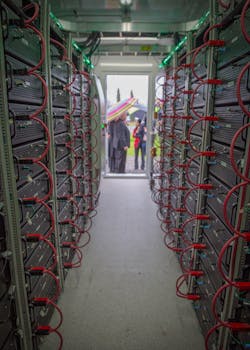According to the Solar Energy Industries Association, “the long-term success of the solar industry depends on the cost-effective integration of energy storage.” By reusing electric vehicle (EV) batteries, researchers at the University of California, Davis are demonstrating a promising solution to this impending challenge. In January 2019, they commissioned a commercial-scale assembly of used Nissan Leaf batteries to store energy from a local solar array.
A close-up view of the used batteries during a recent tour with California Energy Commissioner Karen Douglas.
The “second-life” energy storage system was developed by Professor Jae Wan Park and his graduate students at the UC Davis Green Technology Laboratory. Made possible by a grant from the California Energy Commission, this project is reducing the on-peak energy use and carbon footprint of the UC Davis Robert Mondavi Institute — a combined winery, brewery, and food processing complex. The team assembled approximately 15 Nissan Leaf battery packs, which have a combined energy capacity of 300 kWh, in a shipping container next to the winery. Control algorithms developed by PhD candidate, Joseph Lacap, direct the batteries to charge with excess power from a 200-kW rooftop solar array. The batteries then discharge in the evening to reduce the facility’s carbon footprint and energy use by 20% or more.
According to Professor Park, his team has developed unique strengths since they began exploring EV battery reuse in 2010. For instance, the researchers have learned to reduce the time required to test used battery cells. Rather than spending hours to fully charge and discharge each one, they estimate battery health in minutes using machine learning algorithms. Then, additional algorithms configure cells in series and parallel to optimize performance. Finally, the team reassembles batteries with new controls, which measure and account for variability in battery capacity to ensure safety, efficiency, and longevity.
Importantly, these capabilities are in sync with the needs of California grid operators and consumers. The state now produces about 20% of its power using solar panels and their intermittent output is profoundly impacting grid operations. Already, over-generation in the afternoon is depressing wholesale electricity prices, causing peaks in evening electricity rates, and resulting in curtailment of solar energy. Nevertheless, state policymakers doubled down on solar in 2018 with an unprecedented 100% clean energy target and mandate to install rooftop solar panels on all new residences. Affordable and scalable energy storage would support achievement of these bold goals.
Meanwhile, a combination of public policy and cost declines are driving rapid adoption of plug-in EVs, which now account for more than 10% of all new car sales in California. To mitigate the environmental impacts of EV batteries, the state’s legislature is developing additional rules to ensure they are either reused or recycled at their end of life. Unfortunately, the costs of recycling EV batteries are three times the value of recoverable materials, according to Francisco Carranza, a managing director at Nissan.
Widespread battery reuse may serve to defer hefty recycling costs. Reuse is especially promising given that 75% of an EV battery’s original capacity typically remains at the end of its useful life in a vehicle. This opportunity motivated Professor Park to form RePurpose Energy, a startup on a mission to commercialize his team’s research. According to Ryan Barr, a co-founder of the new venture, the team aims to sell repurposed batteries to commercial solar developers at half the cost of new battery alternatives.
Distributed solar developers are in the market for affordable batteries in states such as California, where demand charges are steep and energy prices in the evening are much higher than in the afternoon. Under such conditions, adding energy storage to a solar array can double the net present value of the combined installation. For this reason, RePurpose Energy intends to assemble its first privately funded system at another winery with on-site solar panels. In this way, the team will profitably redeploy Nissan Leaf batteries to reduce the facility’s electricity bills and carbon footprint.
Electricity bill and emissions reductions are not the only benefits of energy storage, however. Around the country, grid operators are developing new mechanisms whereby batteries may participate directly in wholesale markets. At the same time, utility regulators are recognizing the potential for batteries to mitigate the costs of grid upgrades. Consequently, the grander vision of Professor Park and his team is to aggregate fleets of second-life batteries to provide grid services.
Commercial energy storage using retired EV batteries is now a reality. The next question is whether the approach may be applied at scale to sustain photovoltaic (PV) adoption and further transform grid operations. The founders of RePurpose Energy believe their nine years of experience have prepared them to do so. If they are right, utilities, automakers, and consumers all stand to benefit.



